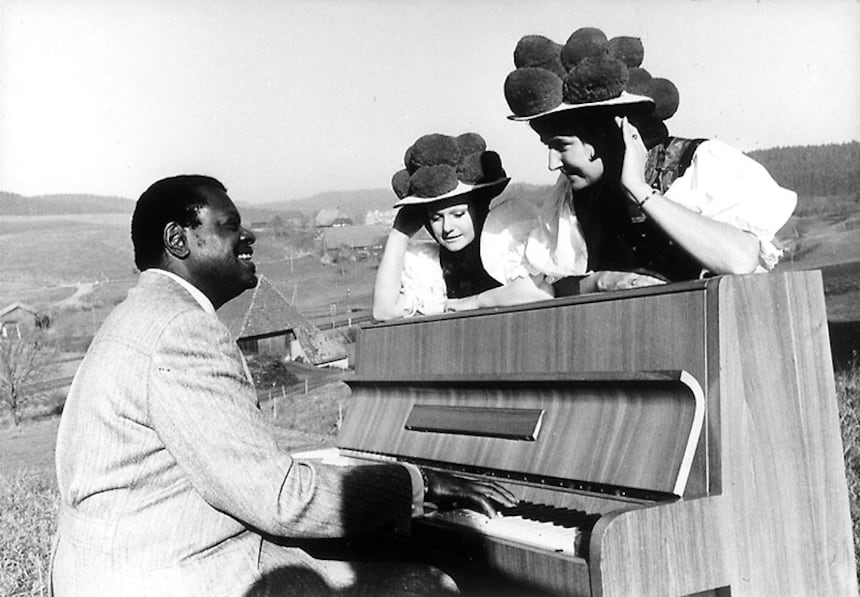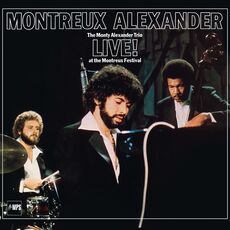50 years ago, no-one would have thought of Germany, and certainly not the Black Forest, as the Mecca of jazz. And yet it attracted so many international artists! What made it so attractive to artists in those days?
I think I could sum it up in one line: it was a place where you could develop the most diverse artistic movements, where you could make records and release them right away. It was a place where even new talents could become visible. At the same time, performers could sign new exclusive contracts, because the big labels weren't very interested in jazz anymore. And it was a place where the 68ers found a musical home where they could test out new artistic movements (free jazz). Joachim-Ernst Berendt also contributed to it, because thanks to him, lots of performers found their way to the MPS studio, what with it being so close geographically to Baden-Baden (Südwestfunk: South-Western radio).
How did you wind up inviting Oscar Peterson to the Black Forest? And how did he react to the invitation?
Hans Georg Brunner-Schwer heard the legendary Oscar Peterson trio with Ray Brown on the bass and Ed Thigpen on the drums for the first time in 1959 at the Zurich Congress Centre. That was when he had the idea of inviting the Oscar Peterson trio to the Black Forest. It wasn't until 1963 that Oscar Peterson actually visited Hans Georg Brunner-Schwer for one of the first private concerts. That was all recorded onto tape. Oscar Peterson listened to the recordings that very night and was extremely enthused, because he had never heard himself playing like that. During the private concert, the trio played until 4am. According to Oscar Peterson, these recordings are so exceptional that he could never match them. And so this experience of the interaction between jazz music and recording technology spread throughout the jazz world. And that's why so many artists wanted to go there to have their turn with this attractive recording technique.
What were the private concerts at Georg Brunner-Schwer's like? Who were the regular invitees?
They were attended by small circle of invitees, mainly made up of family and close friends. But jazz musicians were also invited, for example Wolfgang Dauner, Eberhard Weber, Hans Koller, Toni Stricker, to name but a few. Because there wasn't much room, most people crowded right around the trio. The huge enthusiasm in the room was palpable at all the private concerts.

How did the first recording at MPS go, and what were the legal difficulties facing it in 1968?
In 1968 Hans Georg Brunner-Schwer resigned his post as a technical director of the Schwarzwälder Apparate Bauanstalt (SABA) and set up his own personal label, Musik Produktion Schwarzwald (MPS) on April 1, 1968. There already existed several productions made by the SABA label, which the MPS label took with it and distributed. These covered, for example, recordings of trios with Eugen Cicero, from the Art van Damme quintet, George Gruntz, Rolf Kühn, Hans Koller; or George Duke's first album. When, around that time, Oscar Peterson's contract with Verve expired, he signed an exclusive contract with the MPS label. And so the records of the private concerts could be distributed all over the world. These were the first twelve-inches that the MPS label produced.
What is distinctive about the recording technique and the aesthetic of the MPS sound?
Now there's a difficult question! The special thing about "Most Perfekt Sound" (as the three letters MPS have been said to stand for) is the symbiosis between musicality and the musical ear of the MPS label's founder. Hans Georg Brunner-Schwer had both. He himself played piano and the accordion, and always paid attention to recording techniques. He was intensely interested in the recording techniques that one could use with a microphone. The same went for mixing desks and tape recorders. He could do the recordings personally, and was the direct middleman between the performer and the tape. He mixed the raw recordings himself, by ear, often in the company of the performers. That is particularly audible with the vocal group The Singers Unlimited and Hi-Lo’s, which was the work of the Grammy Award-winning vocal arranger Gene Puerling. Every recording session was followed by sustained listening and mixing. The recordings of the solos by Oscar Peterson, Sir George Shearing and Horst Jankowski on the concert piano, a Steinway grand reflect the aesthetics of the MPS Sound.
After the death of Hans Georg Brunner-Schwers and a 30-year break, MPS has returned with a vast "remastering" project. How did you make the selection from such a rich catalogue?
After Hans Georg Brunner-Schwer passed away, Universal Music sporadically published original albums and compilations. After MPS's acquisition of the rights to EDEL AG in 2013, the individual titles for which there was a high demand were released physically. The whole digital catalogue has been available since early 2018.
How were the negotiations with Universal about the rights to over 500 tracks in the catalogue, and then the revolutionary leap forward with the distributor Edel in 2013? What was the stylistic impact on the label?
The negotiations with Universal Music happened very quickly in 2013; Universal Music wanted to sell off the catalogue fast, because of the fusion with EMI. Edel reactivated MPS as an active label (after their acquisition of MPS in 1983, Polygram/Universal only ever used MPS as a catalogue and never undertook new releases). Today, MPS presents itself as a music label that’s passionate about top-of-the-range quality.






















